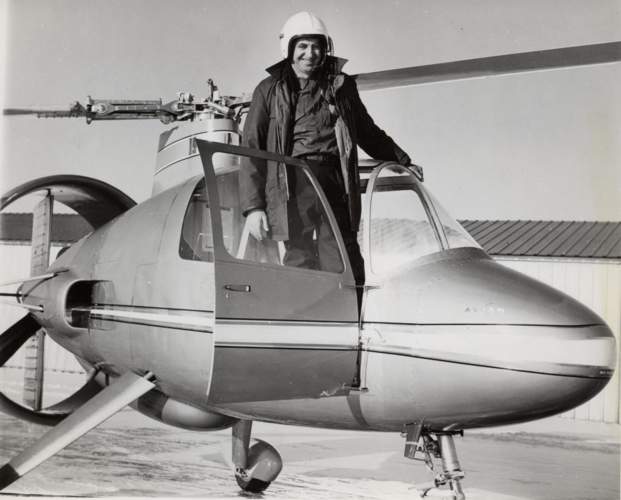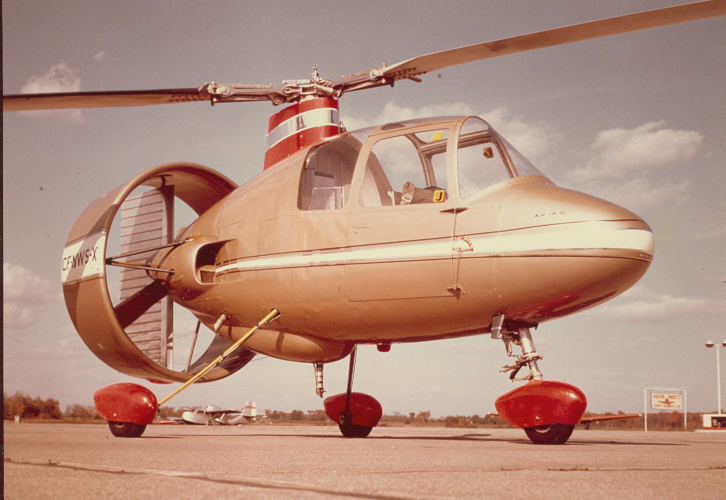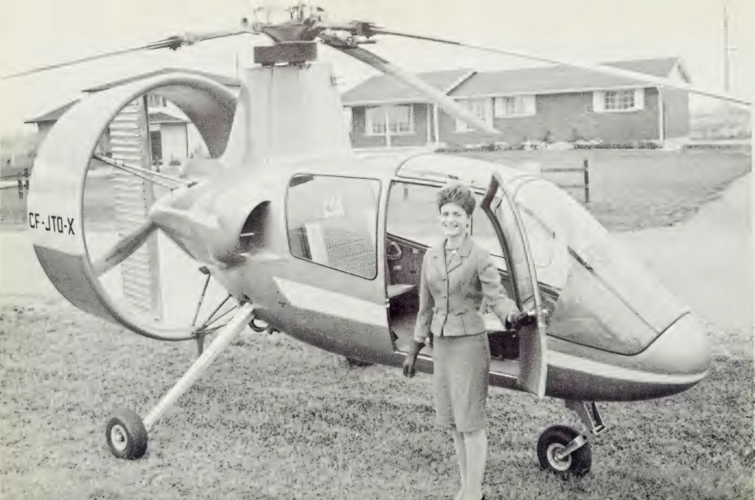The work now in progress throughout the world on gyroplane development is nowhere more advanced than the AVIAN project at Georgetown, Ontario. Although at first glance there seems to be a great similarity between the helicopter and the gyroplane, the principles of flight and control are quite different. One of the chief advantages of the Gyroplane over the Helicopter is the fact that only a few hours of conversion are required for a fixed wing pilot as opposed to the complete course required for Helicopter pilotage. The airflow through the rotor disk of the helicopter in level flight is from the top side due to the disc being inclined downward to achieve forward motion. On the other hand, the gyroplane lift is obtained by the windmill effect of air passing through the disc from the bottom because the disc is inclined backwards in forward flight. The helicopter rotor has to perform three functions; namely lift, thrust and control, whereas the gyroplane rotor is only called upon for lift and control. The thrust is provided by a conventional engine and propeller configuration. It will be readity appreciated that the complex problems of flight and maintenance inherent in the heliconter are not found in the gyroplane. The performance of a modern gyroplane with jump-start capability makes it as versatile as the helicopter with the exception of the latter’s ability to hover, but the dynamics of the gyroplane rotor system permits higher forward speed than obtainable with the helicopter.
Development on the AVIAN 2/180 gyroplane has progressed through five models for the past five years, starting from an elementary open frame design to the sophisticated monocoque construction of today’s aircraft. The basic aim has been to keep to as simple a design as possible consistent with good engineering practice. An example of this philosophy is a simple single aluminum strut undercarriage for ease of manufacture, requiring no maintenance.
One of the distinctive features of the aircraft is the ring shroud or duct which encloses the 200 hp Lycoming engine and pusher propeller. In addition to increasing the thrust from a given diameter propeller, the shroud acts as the unit to stabilize the aircraft in pitch and yaw. The rudder mounted inside the shroud gives directional control down to almost zero forward speeds. The rotor has three blades attached to the hub by steel straps. Working in place of thrust bearings, this system gives a rigid rotor necessary for eliminating ground resonance. Further, no drag dampers or hinges are used, making ground adjustment easy since the blades do not go out of track even under severe operating conditions. The feature of the AVIAN 2/180 that qualifies it as a true V/STOL aircraft is its jump-start capability. The system used is basically very simple and has been explored by others with success. The rotor is spun mechanically with the blades in zero. pitch while the aircraft is still on the ground. When the rotor has reached a predetermined rpm the pilot pulls the take-off lever smartly upward. This action disengages the mechanical drive while applying 10° of positive pitch on the blades. This pitch change plus the kinetic energy stored in the blades is converted to lift and causes the aircraft to jump directly off the ground. When the stored energy is dissipated, the angle of attack is reduced to a pre-set cruise position. The rotor will now auto-rotate under its own power. Except for the jump-start the flying techniques are substantially those used for fixed wing STOL aircraft. Since the rotor is autorotating at all times when airborne it is impossible to stall or spin the aircraft. The rotor is in effect a parachute that can be used gently to lower the aircraft to earth.
The prototype aircraft built over the past five years have differed in detail to optimize the final production aircraft built during 1965 for certification in 1967.






















